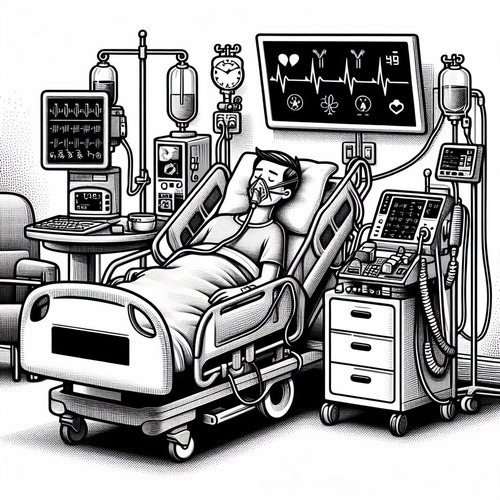At Conception or First Breath: When Does Human Life Begin?
When does human life begin—at conception or at first breath? This question often evokes strong religious and philosophical perspectives. However, there’s substantial scientific evidence, too, supporting the position that our lives begin at conception. Let’s explore the weight of medical evidence supporting this view, focusing solely on biological facts rather than religious teachings.
THE MOMENT OF CONCEPTION: WELCOME A GENETICALLY UNIQUE HUMAN
When a sperm cell fertilises an egg, a profound biological event occurs. The resulting single-cell zygote contains a completely new and unique set of 46 chromosomes—23 from each parent—creating a genetic blueprint unlike any other human that has ever lived. This genetic distinctiveness is scientifically significant; from this moment forward, if properly nourished and protected, this single cell will develop according to its own internal programme.
Dr. Micheline Matthews-Roth, Principal Research Associate at Harvard Medical School’s Department of Medicine, has stated: “It is scientifically correct to say that an individual human life begins at conception, when egg and sperm join to form the zygote, and this developing human always is a member of our species in all stages of its life.”
DEVELOPMENTAL CONTINUITY: ONE UNINTERRUPTED LIFE PROCESS
From a scientific perspective, human development follows a continuous trajectory. There isn’t a clear biological demarcation that suddenly transforms a “non-human” entity into a human being. The transition from zygote-to-embryo-to-foetus-to-infant involves quantitative changes (growth, increasing complexity) rather than qualitative ones (becoming human).
Consider this developmental timeline:
- Fertilisation: Complete genetic identity established
- 24 hours: First cell division occurs
- Day 5-7: Blastocyst forms; implantation begins
- Week 3: Heart cells begin pulsing
- Week 6-7: Brain waves detectable
- Week 8: All major organs formed
Each of these milestones represents the development of an already-existing human life—not the start of it. The only non-arbitrary starting point for human life is conception—every other potential marker occurs on a spectrum, making them subjective rather than objective boundaries.
CELLULAR BIOLOGY: ALL SIGNS OF LIFE PRESENT AT FERTILISATION
From the moment of conception, the zygote exhibits all biological characteristics scientifically recognised as signs of life:
- Metabolism: The zygote immediately begins consuming nutrients and converting them to energy
- Growth: Rapid cell division begins within hours
- Response to environment: Even single-celled zygotes respond to environmental stimuli
- Self-directed development: The embryo develops according to its own genetic programme—independent of the mother’s body
This scientific reality is acknowledged in standard embryology textbooks. For example, in “The Developing Human: Clinically Oriented Embryology,” Moore, Persaud, and Torchia write: “Human development begins at fertilisation, the process during which a male gamete or sperm unites with a female gamete or oocyte to form a single cell called a zygote. This highly specialised, totipotent cell marks the beginning of each of us as a unique individual.”
ADDRESSING SCIENTIFIC COUNTER-ARGUMENTS
Several counter-arguments regarding when life begins deserve scientific examination:
- The Viability Argument: Some suggest human life begins at viability—when the foetus can survive outside the womb. However, viability is constantly shifting with medical advances and refers to dependency, not biological humanity. A newborn is equally dependent on others for survival—only in ways that are different from that of a foetus.
- The Brain Activity Argument: Others propose life begins with brain activity. Yet cellular life clearly exists before brain development, and the brain develops on a continuum rather than “switching on” at a specific moment. The scientific question is not “when does consciousness begin?” but “when does a distinct human life begin?”
- The Twinning Possibility: Some argue that because embryo splitting (creating identical twins) can occur until around day 14, individual human life doesn’t begin until after this possibility ends. However, this argument confuses identity with individuality. The original embryo is still a living human organism; twinning simply creates a second distinct human from the first—a form of asexual reproduction.
MEDICAL RECOGNITION OF EARLY HUMAN LIFE
Modern medical science increasingly acknowledges human life’s early beginnings. High-quality ultrasound technology now reveals detailed embryonic development as early as 6-7 weeks, showing coordinated movement, developing organs, even a beating heart.
Foetal surgery, now performed as early as 15-18 weeks, treats the foetus as a distinct patient separate from the mother. Medical specialties such as embryology and foetology exist precisely because medicine recognises the unborn as developing human lives worthy of study and medical care.
The American College of Paediatricians has stated: “The predominance of human biological research confirms that human life begins at conception—fertilisation. At fertilisation, the human being emerges as a whole, genetically distinct, individuated zygotic living human organism, a member of the species Homo sapiens, needing only the proper environment in which to grow and develop.”
CONCLUSION: WHEN DOES HUMAN LIFE BEGIN?
When we follow scientific evidence without philosophical or religious preconceptions, we find strong support for human life beginning at conception. This position doesn’t require religious faith—only an honest assessment of biological facts. The zygote is genetically unique, living, and distinctly human—qualities that persist throughout all developmental stages, and well into adulthood.
Understanding this scientific reality should inform our ethical discussions about human life, regardless of one’s religious or philosophical perspective. The evidence for life beginning at conception comes not from ancient texts but from modern medical science’s increasing understanding of human development.
REFERENCES
- Moore, K.L., Persaud, T.V.N., & Torchia, M.G. (2020). The Developing Human: Clinically Oriented Embryology (11th ed.). Elsevier.
- Sadler, T.W. (2018). Langman’s Medical Embryology (14th ed.). Wolters Kluwer.
- Carlson, B.M. (2019). Human Embryology and Developmental Biology (6th ed.). Elsevier.
- American College of Paediatricians. (2017). When Human Life Begins. Position Statement.
- Condic, M.L. (2014). When Does Human Life Begin? A Scientific Perspective. The Westchester Institute for Ethics & the Human Person.
WHEN DOES HUMAN LIFE BEGIN? RELATED FAQs
What does the Bible say about when human life begins? Throughout Scripture, God consistently recognises human life before birth. In Psalm 139:13-16, David writes, God “knit me together in my mother’s womb” and “saw my unformed body.” Jeremiah 1:5 states, “Before I formed you in the womb I knew you, before you were born I set you apart.” In Exodus 21:22-25, the law treats harm to an unborn child as harm to a person. Luke 1:41-44 describes John the Baptist leaping in Elizabeth’s womb when Mary, pregnant with Jesus, arrives—recognising personhood before birth. While the Bible doesn’t use modern scientific terminology, its consistent message affirms human life and personhood beginning before birth, aligning with the scientific evidence that life begins at conception.
How do foetal development milestones compare with common gestational limits for abortion? Many abortion laws use gestational age limits that don’t align with key developmental milestones:
- 6 weeks: Heartbeat clearly detectable; brain development beginning
- 8-10 weeks: All major organs formed; distinct fingers and toes; responds to touch
- 12 weeks: Sucking reflex developed; can make facial expressions; unique fingerprints formed
- 16-18 weeks: Can hear sounds; has established sleep-wake patterns
- 20-24 weeks: Common viability threshold in medicine, though survival has been documented earlier with advanced medical care
Many jurisdictions permit abortions well past the point when the unborn child has developed these distinctly human characteristics. For example, some countries allow abortion up to 24 weeks—by which point the child has been hearing sounds, including possibly the mother’s voice, for weeks. This disconnect between development and legal standards raises important ethical questions about the adequacy of gestational age as the primary determinant for abortion limits.
How is the term “clump of cells” scientifically inaccurate when describing human embryos? The phrase “clump of cells” is scientifically misleading when applied to human embryos for several key reasons:
- Organised structure, not random clumping: By day 5-7, the embryo (blastocyst) already has a complex, organised structure with distinct cell layers that will develop into specific body systems.
- Self-directed development: Unlike actual cell clumps (like tumours), embryos follow a sophisticated developmental program directed by their own genetic code—not the mother’s.
- Integrated functioning: Even at early stages, embryonic cells communicate and work together as a coordinated organism, not as independent cells.
- Genetic uniqueness: From conception, the embryo possesses a complete, unique human genome distinct from both parents.
- Developmental continuity: The embryo is not a potential human but a human at an early developmental stage—just as an infant is, compared to an adult.
When abortion providers use terms like “clump of cells” or “tissue,” they employ scientifically imprecise language that fails to acknowledge the biological reality of early human development. By 8 weeks, when many abortions occur, the embryo has developed all major organ systems, has a beating heart, and shows measurable brain activity—far beyond what could accurately be described as a “clump of cells.”
What evidence of life do foetuses show during the abortion process? [Note: The following information is presented factually for educational purposes.] Medical documentation shows foetuses exhibit several signs of life during abortion procedures, particularly in later gestational ages:
- Withdrawal responses: Medical literature documents that foetuses demonstrate withdrawal movements when touched by surgical instruments during abortion procedures—similar to reflexive movements away from painful stimuli.
- Increased stress hormones: Studies have detected elevated stress hormones in foetuses during invasive procedures, indicating physiological stress responses.
- Heart rate acceleration: Monitoring has shown accelerated foetal heart rates during abortion procedures, consistent with autonomic nervous system responses to distress.
- Movement away from instruments: Ultrasound imaging during procedures has recorded foetuses moving away from suction cannulas and other instruments—a response pattern seen in living organisms.
- Increased foetal activity: Some abortion providers have reported increased foetal movement during the initial phases of abortion procedures before foetal demise occurs.
These physiological responses are consistent with those exhibited by living organisms reacting to threatening stimuli, raising significant ethical questions about foetal pain perception and consciousness that medical science continues to investigate.
How do embryologists and physicians specialising in foetal development view the beginning of human life? When we turn to specialists who study human development professionally, we find strong consensus that human life begins at fertilisation:
- Keith L. Moore, award-winning embryologist and textbook author: “Human development begins at fertilisation, when a sperm unites with an oocyte to form a single cell, the zygote.”
- Maureen Condic, Associate Professor of Neurobiology: “The scientific evidence supports the conclusion that a zygote is a human organism and that the life of a new human being commences at a scientifically well-defined ‘moment of conception.'”
- Jerome Lejeune, geneticist who discovered the chromosomal basis of Down Syndrome: “To accept the fact that after fertilisation has taken place a new human has come into being is no longer a matter of taste or opinion… it is plain experimental evidence.”
- American College of Paediatricians: “The predominance of human biological research confirms that human life begins at conception.”
While ethical conclusions about abortion may vary among medical professionals, there is remarkable scientific consensus about the biological beginning of human life. This distinction between scientific fact (when life begins) and ethical judgment (policy implications) is important when evaluating medical perspectives.
How does embryo adoption provide an alternative perspective on the humanity of early embryos? Embryo adoption—the process where embryos from IVF procedures are adopted by couples who cannot conceive naturally—offers a compelling counterpoint to the “clump of cells” narrative:
- Approximately 1 million frozen embryos exist in the United States alone
- Embryo adoption programmes treat these embryos as potential human lives deserving protection
- Thousands of children born through embryo adoption demonstrate the continuous human development from embryo to child
- Many families celebrate their children’s “double birthday”—transfer day and birth day
When families adopt embryos that would otherwise remain frozen indefinitely or be discarded, they affirm through their actions the humanity of the embryo from its earliest stages. The existence of “Snowflake children” (a term for those born through embryo adoption) demonstrates that what some dismiss as merely “cells” can, when given proper environment and nurture, develop into fully-realized human children.
WHEN DOES HUMAN LIFE BEGIN? OUR RELATED POSTS
Editor's Pick

Why Do People Hate the Doctrine of Election?
…WHEN THEY REALLY SHOULDN’T Few Bible doctrines provoke stronger reactions than election. The idea that God chose some for salvation [...]

The Doctrine of Providence: Does God Really Govern All Things?
You’re sitting in the doctor’s office when the diagnosis lands like a thunderclap. Your mind races: Why this? Why now? [...]

No Decay, No Defeat: What It Means That Christ’s Body Saw No Corruption
On the Day of Pentecost, Peter stood before thousands and made a startling claim: David's body decayed in the tomb, [...]
SUPPORT US:
Feel the Holy Spirit's gentle nudge to partner with us?
Donate Online:
Account Name: TRUTHS TO DIE FOR FOUNDATION
Account Number: 10243565459
Bank IFSC: IDFB0043391
Bank Name: IDFC FIRST BANK






